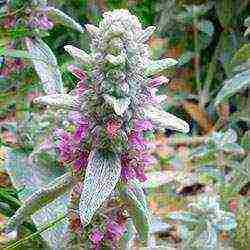Content
- 1 Types and varieties of thyme (thyme)
- 2 Top 5 varieties of thyme (thyme) for home growing
- 3 Thyme breeding methods
- 4 Features of care at home and in the country
- 5 Thyme care rules
- 6 Answers to questions about growing thyme
- 7 Review of the cultivation of thyme
- 8 How to avoid mistakes when growing
- 9 Landing
- 10 Video "Everything Gardeners Need to Know"
- 11 Growing and care
- 12 Reproduction
- 13 Which varieties to choose
- 14 Video "How to plant thyme"
Thyme (thyme) is valued not only for its medicinal properties, but also as an excellent spice, flavoring seasoning for many dishes and aromatic drinks in cooking. It is unassuming to care for, so it is often grown both outdoors and in a room on a windowsill. Many summer residents, highly appreciating the decorativeness of some varieties, use thyme to decorate the site. We will tell in the article how to grow thyme from seeds in the country or at home, how to squeeze, what care features are required for the plant.
Types and varieties of thyme (thyme)
The genus of thyme is very extensive, in nature there are more than 200 of its species. When breeding varieties, breeders mainly use the following types of thyme (thyme):
- ordinary;
- creeping;
- lemon-scented;
- early.

Some species are successfully used as flowering and ornamental shrubs for arranging flower beds, decorating hills, borders.
The commercially available seeds of various varieties of thyme (thyme) are suitable both for open ground and for growing in a room on a windowsill. Plants will decorate a room or garden, and freshly picked leaves and shoots will add a wonderful aroma to food and drinks and will be used in recipes for traditional medicine. Read also the article: → "Spicy herbs in the country."
Top 5 varieties of thyme (thyme) for home growing
The most popular varieties are presented in the table:
| N / a | Variety name | Characteristics |
| 1. | Snake | The rapid appearance of the first greenery for cutting, the leaves are small, the flowers are bright, pink with purple, creeping shoots up to 35 cm |
| 2. | Aibolit | Early ripe, well leafy, small leaves, light pink flowers with a purple tint |
| 3. | Citric | The height of the semi-shrub is up to 30 cm, the flowers are white, the leaves are fragrant with a lemon-spicy taste, slightly pungent |
| 4. | Nectar | Creeping plant, pink flowers, stem height up to 25 cm, large yield of spicy foliage |
| 5. | Rainbow | It grows up to 20 cm tall, the leaves have a very strong aroma, a high content of vitamins and microelements |
Thyme breeding methods
Thyme can be propagated in many ways, each of which is applicable in one case or another.
Seedless method (by seeds)
- Seeds are sown in open ground in spring, buried in well-moistened soil, but no more than 0.5-0.7 cm, since they are very small. Top them lightly sprinkle with sand or peat. The plantings are covered with polyethylene until the first shoots appear, usually it will take about 2-2.5 weeks.
- Plants, especially erect varieties, are usually placed in beds in a pattern of 40-60 cm between rows and 10-20 cm between plants in a row.
- At first, the thyme grows very slowly, after the appearance of the first true leaves, it is thinned out. For decorative purposes, it is possible to grow with a solid carpet, without thinning.
Savory (thyme, thyme) - grown from seeds
- The soil must be constantly loosened and carefully monitored so that a crust does not form.
- Good results are given by sowing before winter, on frozen ground. In areas with harsh winters, adult plants in the fall are spud and covered with spruce branches.
Tip # 1. In order to prevent thyme from freezing out in areas with severe winters, planting is mulched, it is often grown as an annual. Individual specimens can be transplanted into pots in the fall and installed on the windowsill.
Seedling method of breeding thyme
- Seedling growing is considered more reliable. Since the seeds of thyme are quite taut and the sprouts that appear are very small, they can easily die in the open field.
- For growing seedlings, containers with a depth of 8-10 cm are used. The bottom is filled with drainage material (2-3 cm), because the plants need a good outflow of water. It can be fine gravel, expanded clay, crushed stone.
- A soil mixture is poured on top, lightly compacted and abundantly moistened with a sprayer.
- Seeds are spread over the ground, trying to avoid excessive thickening, and lightly sprinkled with sand. The container is covered with foil or glass, creating a humid and warm microclimate, and regularly ventilated.
- When sprouts appear (after 2-2.5 weeks), the containers are transferred to a cooler and well-lit place. At first, the film is periodically moved aside for a while for airing and hardening the sprouts, removing it on warm days, and later completely removed.
- Young plants in the phase of 2 leaves dive or thin out, leaving a feeding area for one sprout of about 2x2 cm.
- Seedlings can be planted in the ground after 60-65 days. For this, cloudy days are chosen, preferably after rain, the plantings are shaded for the first time. Read also the article: → "Spicy herbs - we grow ourselves."
Tip # 2. Thyme seeds will germinate faster at elevated temperatures and humidity; when sprouts appear, they must be gradually reduced.
Propagation by cuttings and root layers
- In creeping species, the processes can take root on their own, overgrowing with roots. Root layers are cut off from the mother plant, dug up and planted.
- Some species are propagated by lignified cuttings, which are cut into 3-5 cm, pre-rooted in a greenhouse or immediately planted in a permanent place under a film for rooting.
Growing thyme by dividing the bush
- In the spring, large bushes are dug up and the roots are carefully disassembled. The plant is divided into separate parts with shoots of the root system. They are planted in moist soil with an embedment of 4-6 cm.

Thyme can be propagated by dividing the bush, embedded in moist soil to a depth of 4-6 cm
Growing at home
- On the windowsill, thyme can be grown all year round, using both seedless and seedling methods.
- In the presence of adult plants, vegetative propagation methods are applicable - by cuttings, layering and dividing the bush.
- For home cultivation, varieties with compact sizes and erect stems are suitable.
- To avoid excessive stretching of the shoots, additional lighting will be required in the autumn-winter time.
Features of care at home and in the country
In order for the bushes to always be lush, green, it is necessary to observe the conditions of growing and care.
Watering and loosening the soil
- Loose and light soils with a neutral reaction are preferred, thyme will not grow on clay soils.
- The main condition is good drainage, since the plant does not tolerate even the slightest waterlogging and stagnation of water. Good results are obtained by using fine gravel as mulch.
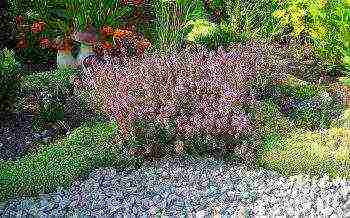
Using fine gravel as mulch keeps water from stagnant
- The moisture permeability of the soil can be ensured by using equal parts of soil mixture, sand and peat for germinating seeds and rooting cuttings.
- Plants will need loosening of the soil, removing weeds.
Requirements for watering bushes
- Watering should be moderate, but constant, the soil should not be allowed to dry out.
- In dry summer periods, with active regrowth of shoots in spring and during flowering, watering is slightly increased.
- Waterlogging causes great harm to plants. If it rains for a long time and the soil becomes saturated with moisture, the roots may begin to rot.
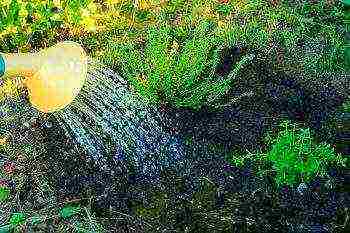
Watering should be moderate, both waterlogging and overdrying of the soil is not allowed
The need for lighting in summer and winter
- The plant prefers well-lit and sunny places.
- It can withstand light partial shade and shading, but it will bloom poorly and stretch out strongly, losing its decorative effect.
- When grown on a windowsill in winter, illumination of 40-55 W / m2 will be required. Read also the article: → "How to grow onions and other greens in an apartment."
Indoor temperature and humidity
- In open ground, excessive overheating, overdrying or waterlogging of the soil must not be allowed.
- Before the first shoots appear, a higher temperature and humidity (+ 20-22 ° C) will be required. When growing seedlings, the temperature is gradually reduced (up to + 15-18 ° C), hardening the plants.
Fertilization and dressing
- Before planting, organic matter (2-3 kg per 1 m2) and nitrophosphate (30 g) are introduced into open ground.
- Plants in the open field are fed with complex fertilizers two or three times per season, especially they need feeding after harvesting raw materials.
- When growing seedlings, plants are fed 1-2 times with universal fertilizers with microelements, following the instructions. You can use wood ash and spraying with Epin-extra.
Shoot picking time
- In the first year (when grown from seeds), individual, longest shoots are selectively cut off.
- For medicinal purposes and for making drinks, thyme is harvested in dry weather, during flowering, which begins in the second year. In this case, the stem is cut off, leaving 7-10 cm at the root. The second harvest can be repeated in the fall, as the shoots grow back.
- For eating, use young shoots with delicate leaves.

For culinary use, young shoots and leaves are plucked
Thyme care rules
The basic rules of care are presented in the table:
| Care type | Peculiarities | Recommendations |
| Watering | Moderate but regular | Thyme does not tolerate waterlogging, stagnant water and strong drying out of the soil |
| Temperature | + 15 ... + 20 ° С | A higher temperature is required before the emergence of shoots, then it is gradually reduced |
| Agricultural practices | Weeding, loosening | The soil needs regular loosening so that the formed crust does not interfere with the access of oxygen |
Answers to questions about growing thyme
Question number 1.I grow thyme in the open field, but it blooms and develops poorly. What is the reason?
It is possible that the soil is not suitable for the plant, it is too acidic. Other reasons are the location of the plantings in the shade or stagnant water in the garden.
Question number 2.Thyme, planted on an alpine hill, grows and stretches very much, its decorative effect is lost. What can be done?
For an alpine slide, it is best to change the variety, choosing creeping species with miniature and compact bushes for planting.
Question number 3.Is it possible to sow thyme seeds in open ground not in spring, but in summer or autumn?
Sowing can be carried out at any time, but it must be borne in mind that young plants must have time to root sufficiently before the first frosty days. For the winter, they should be spud and covered.
Question number 4.When is the right time to cut thyme for medicinal purposes?
Most of the useful substances are contained in flowering thyme, therefore cutting is carried out during flowering.
Question number 5.What can be done to make potted plants on the windowsill more compact?
More compact bushes with a dense green mass are obtained with regular pruning, overgrown shoots are cut to a lignified base. For home cultivation, it is better to select low, upright varieties.

When grown on a windowsill, the thyme is placed in the sunniest place.
Review of the cultivation of thyme
Fragrant thyme is known for its medicinal and taste properties, so I have been growing it for several years in my summer cottage, and it invariably pleases us with its decorative effect. Recently, I decided to plant it at home so that when I cook, there are always spicy leaves at hand.
There is nothing super complicated in growing it, but you still have to take into account some basic points. In the open field, the seedling method is more suitable, so the thyme takes root better. The seeds are very small, germinate for a long time, so you need to keep an eye on them, observe the regime of high temperature and humidity.
But even when the first shoots appear, they are very tiny and grow slowly, the weeds can destroy them, this will also have to be constantly monitored. But in the spring, I visit from time to time, so it is more convenient for me to bring ready-made seedlings grown on the windowsill with me.
- For planting seeds for seedlings, I use low containers, on the bottom I spread a layer of fine expanded clay, well washed and scalded with boiling water. Thyme does not tolerate stagnant water, and containers should have good drainage.
- It is best to take the soil for the initial germination of seeds that is not rich in nutrients. It might just be a mixture of sand and peat, because if you use a regular nutrient mixture, the high humidity will encourage mold growth.
- Before planting, I water and compact the soil abundantly, then I spread the prepared seeds on its surface, trying to distribute them evenly, and cover the container with glass (you can use a film). I put it in the warmest place, constantly keep the soil moist, and after about 2 weeks the first shoots begin to appear.

Thyme shoots appear in about 2 weeks
- In a state of 2-3 true leaves, I dive seedlings, but I already make up the soil from equal parts of peat, sand and a universal soil mixture. The plant will be ready for planting in the country in 2 months.
- I prepare the land in the garden in advance, dig it up, mixing it with sand. I add a universal fertilizer, as well as well-rotted compost. Please note that the soil should be light and loose; heavy clay soils, on which the water will start to stagnate, will not work. At first I shade the plants, then I provide timely watering, weeding and loosening of the crust.
- I leave a little seedlings for growing in the kitchen. On cloudy and winter days, the thyme will need additional lighting, otherwise it will stretch a lot. I especially liked the varieties "Lemon" and "Medoc".
How to avoid mistakes when growing
Mistake # 1.Growing thyme on clay soils where water stagnates. The roots start to rot and the plant gets sick and disappears.
The soils should be light, with the addition of sand, moisture and air permeable. Plants need good drainage.
Mistake # 2.Due to the placement of the thyme in the shade, it is very stretched, sick and does not bloom well.
How to avoid? Plant light-loving thyme in well-lit, sunny areas.
Rate the quality of the article. We want to be better for you:
Hello!
Today I will share with you my joy, my favorite spice - thyme!
Rather, a story about the variety that grows with me))
- Vegetable thyme "Medok", nice to meet you!
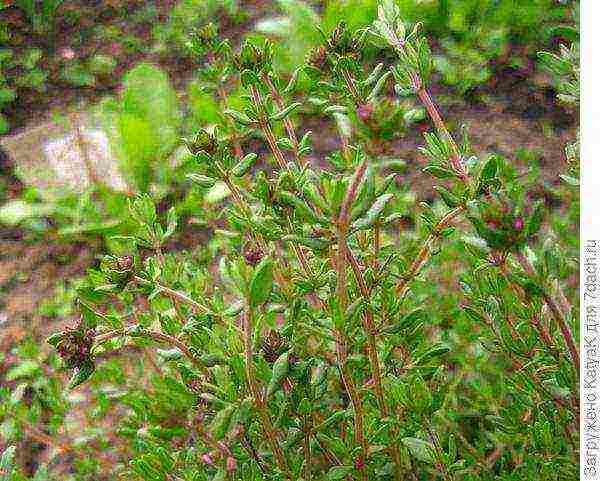
Thyme
The idea to plant spices came to me in 2016, at first I decided on lavender, then I wanted a spicy flower bed with mint, rosemary, then I remembered that thyme tea is my favorite tea.
I bought the first thyme, aka thyme, which was caught.
I have it from Aelita.
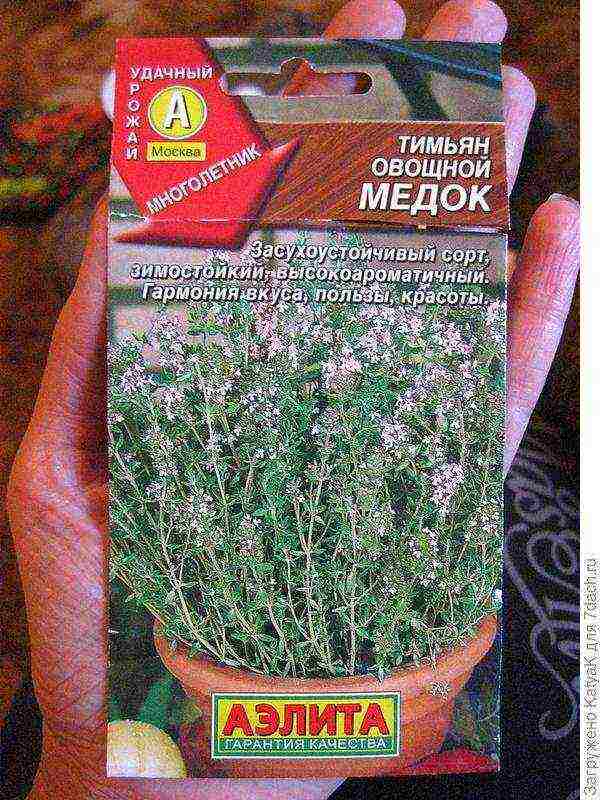
Thyme
When I planted it on seedlings, I don’t remember now, I didn’t do anything special to increase germination, I just spread the seeds over the soil surface, moistened it with a spray bottle and covered it with a film.As soon as the first shoots appeared, she opened the thyme.
Here's a seedling I got.
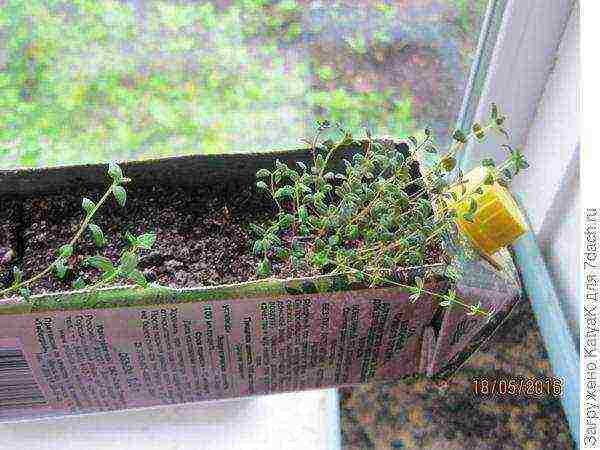
Thyme
Also, my thyme grows in the "wiring" bed. I just planted it with seeds, and it grew. While the first shoots appeared, I watered carefully so that there were no crusts on the ground, then the watering was reduced to about once every 2 weeks. Now I don't water at all yet ...
Thyme does not like watering, it does not need excess moisture.

But the thyme, which grows in a spicy flower bed, there is less sun here, and my fragrant friend is only going to bloom. It should be noted that flowering begins only in the second year.
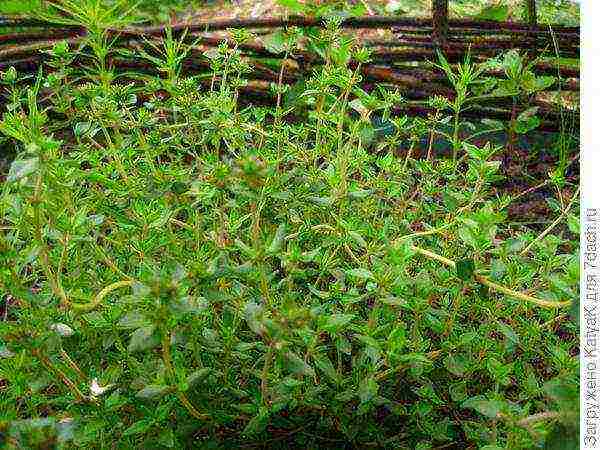
Thyme grows quickly, very quickly! If you lift the green mass, you can see how little shoots crawl out of the stems.

Here, it has finally bloomed!
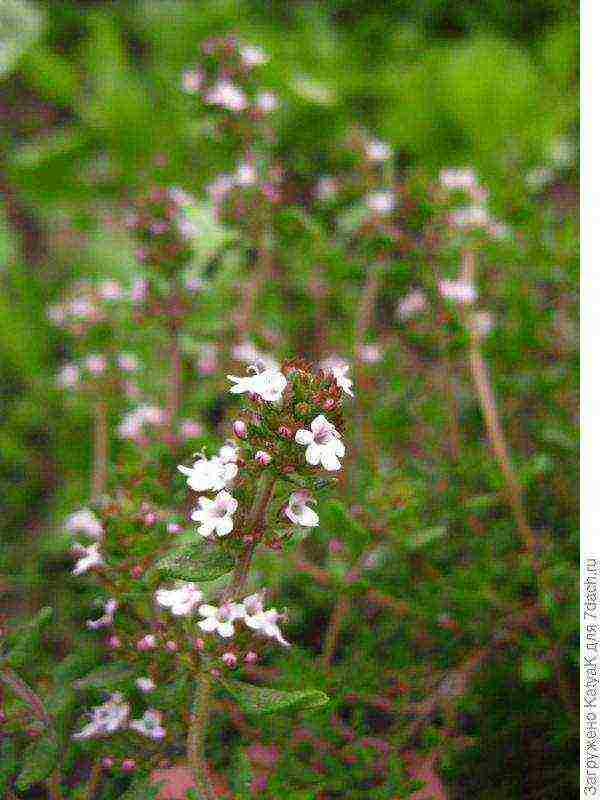
What can I say, the correspondence to the picture is complete. And it pleases!
What I love thyme for is the flavor! Sometimes I walk past the garden and sit down just to shake the bush - the aroma is divine!
From the first year I managed to dry a few bunches of fragrant thyme.
In the photo below, fresh and dried thyme.

What am I doing with him.
First, I add a twig to the sauces before the end of cooking.
For example, my husband's favorite dish: shrimp in a creamy garlic sauce, thyme gives the sauce a special flavor.

Well, the classic of the genre is tea!
I love different combinations, but my favorite is thyme with a couple of black tea leaves. Soothing and delicious!
Well that's all, my story about thyme has come to an end.
For me, thyme is one of my favorite spices, I like its aroma and unpretentious cultivation!
Enjoy your tea!
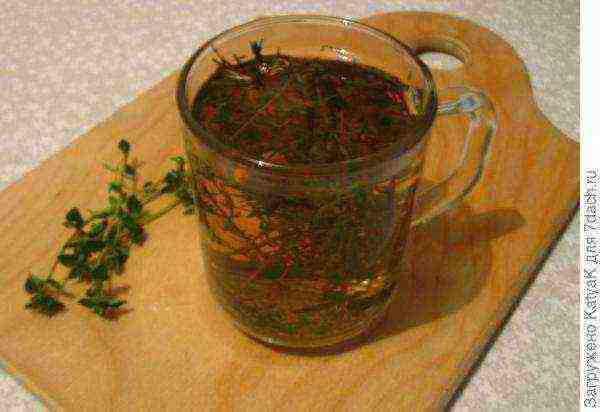
Thank you for your attention!
Thyme, popularly known as thyme, is a perennial decorative shrub with an original spicy taste and aroma. A huge amount of vitamins, acids, mineral, tannins and essential oil substances are concentrated in the leaves of plants, thanks to which thyme cultivation from the seeds of which is widely practiced by gardeners, is used in folk medicine, cooking, and perfumery. Some varieties of thyme have excellent decorative qualities, which have earned the increased attention of aesthetes and landscape designers.
Landing
For planting thyme, you need loose, fertile and well-drained soil with neutral acidity, which is prepared in the fall. During the autumn digging, organic fertilizers are introduced into the soil: compost, humus. Seeds are planted in the ground at the end of May, when the ground has warmed up well, or through seedlings.
Many housewives want to have a decorative bush on the windowsill and are interested in: how to grow thyme at home? For planting, you will need any container (flower pot), on the bottom of which you need to lay drainage and pour soil mixture. Then the pre-soaked seeds are distributed on the surface, sprinkled on top with a layer of earth, and covered with glass until shoots appear. The optimum temperature for seed germination is considered to be 15-17 ° C, which must be artificially created at home. To grow thyme in a garden or vegetable garden, you should choose sunny open areas, since the concentration of nutrients and esters in the leaves of plants depends on this.
Video "Everything Gardeners Need to Know"
Informational video with useful properties of thyme, as well as data on its cultivation.
Growing and care
Caring for thyme in the garden consists of regular watering, weeding and feeding. Shrubs growing in the garden only need watering and feeding. If the seeds are sown in open ground, then about 2 weeks after germination, the plants need to be thinned, leaving the largest ones at a distance of 10-15 cm, and the soil should be loosened. In the future, weeding and loosening are carried out at intervals of 1 time / 2 weeks.
Water the thyme often, but make sure that the soil is not too wet - the culture tolerates drought better than excessive moisture.Top dressing is applied several times during the season: in the fall when digging a site - organic matter, in the spring before planting and before harvesting - mineral mixtures (superphosphate, saltpeter).
Harvesting begins during the flowering period (June-August). Flowering shoots are cut with a sharp knife at a level of 8-10 cm above the soil surface. For the winter, the bushes are cut, spud, and then covered with compost, humus and dry leaves.
Reproduction
Thyme can be propagated in several ways:
- planting seeds directly in the garden;
- through seedlings, which involves sowing seeds in early spring at home in containers or pots;
- dividing the bush;
- by cuttings.
Since thyme seeds germinate in the open field for a long time and poorly, it is best to grow the crop through seedlings. This method allows you to plant already matured young plants in the spring, and avoid unnecessary hassle with sowing in the garden.Experienced gardeners prefer to grow thyme by cutting, or dividing the rhizome. When the bush fades, with sharp scissors you need to cut branches 10-15 cm long, remove the leaves, then deepen the cuttings with one end into wet sandy soil and cover with foil. Every day, the soil must be moistened until leaves appear on the branches - this means that the roots have sprouted and the plants can be replanted. There are other ways thyme can be propagated. Creeping varieties tend to strengthen with roots in the soil, and thus multiply independently.
Which varieties to choose
The genus Thyme has about four hundred species, of which about two hundred grow in our latitudes. In the wild, thyme is found in meadows, mountain slopes and rocks, and its cultivated varieties are planted in the garden bed, in the garden, and are also used to decorate the landscape in the country - flowering ground cover varieties look very impressive on alpine hills, cascade flower beds, and just along stone tracks. Thyme shrubs surprise with their diversity. Depending on the species and variety, plants differ in the shape and size of the bush (from 15 to 40 cm, creeping thyme has a height of only 5-8 cm), the color of the leaves - from light green with stripes to dark, and even grayish. The multiple inflorescences of white, yellow, different shades of lilac, and also pink color, located at the ends of the shoots, give a special decorative effect to the shrubs.
When choosing a thyme variety, you need to consider the purpose of the plants. If the culture will be planted in a garden or on a plot near a house for decorative purposes, then it is better to choose flowering creeping species. If for treatment or eating, then you need to choose aromatic varieties with a high content of essential oils.
In our climate for growing in the country, as well as on the windowsill in the apartment, the following types of thyme are best suited:
- Creeping. It is a low shrub with long creeping shoots. The plant is very unpretentious and frost-resistant, grows well in the wild on sandy soils. Creeping thyme has good decorative properties: it grows quickly, forming a dense carpet on the surface, and blooms very intensively with purple inflorescences throughout the summer. Due to these qualities, creeping thyme is often used by designers to decorate flower beds, lawns, slopes in a rocky garden.
- Ordinary. This type of thyme is the most popular because it has the most pronounced taste and aroma. It is grown primarily for medicinal and culinary purposes. The shrub is quite compact (15-20 cm in height) with slightly spreading branches, which allows it to be planted not only in the country, but also in a pot on the windowsill.
- Citric. Varietal thyme with a pronounced lemon aroma. It is used for cooking and has good medicinal properties. The bush is compact (20-30 cm), the flowers are small, pale lilac. Heat-loving, like all hybrids, does not tolerate frost well.
- Nectar.Vegetable hybrid with slightly creeping, but heavily leafy branches. It has a slightly bitter taste and delicate aroma. Differs in high productivity and cold resistance.
Other varieties of thyme can also be used in landscape design. For example, the decorative variety "Mossy" is distinguished by small intertwining leaves with lilac inflorescences, due to which it forms a thick carpet 1-2 cm high on the soil surface.
Video "How to plant thyme"
Demonstration video with recommendations for planting thyme.

Thyme today is in great demand not only among gardeners. And this is due to the fact that ordinary people began to actively grow the culture, since the plant is valued for its healing properties and as an excellent spice, flavoring seasoning. Gardeners, on the other hand, grow thyme to decorate a flower bed or flower garden, because the culture has amazing decorative properties.
Content
- 1 Description and types
- 2 What the seeds look like
- 3 How and when to plant
- 3.1 Seedless way
- 3.2 Seedling method
- 4 How to care
- 4.1 Watering
- 4.2 Top dressing
- 4.3 Pest and disease control
Description and types
Thyme is a perennial crop that grows as a dwarf shrub. It has a creeping stem and twigs with flowers. Its foliage is small, oval and opposite. At the tips of the branches, small inflorescences flaunt, which are collected in small flowers. They can be pink or lilac. Thyme oil contains many organic compounds, mineral salt and vitamin C.
Among the whole variety of thyme varieties, the following types of plants are in great demand among gardeners:
- Snake... The culture is characterized by the fact that it quickly has the first greens for cutting. The leaves are small, the inflorescences are bright. They can be pink or lilac. Shoots are creeping, and their height reaches 35 cm.
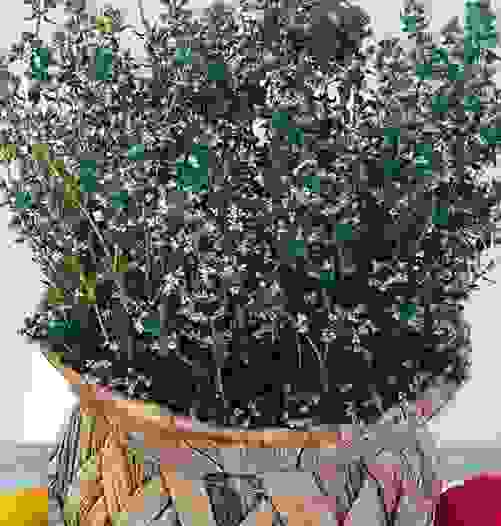
Thyme Snake
- Aibolit... This is an early maturing variety. It has an abundant green mass. The leaves are small, the flowers can be light pink or lilac. But what a fast-growing perennial hedge looks like in the photo can be seen here.

Thyme Aybolit
- Citric... This plant grows to a mark of 30 cm. It has old flowers, fragrant leaves, tasting which one can feel a lemon-spicy and slightly burning taste.
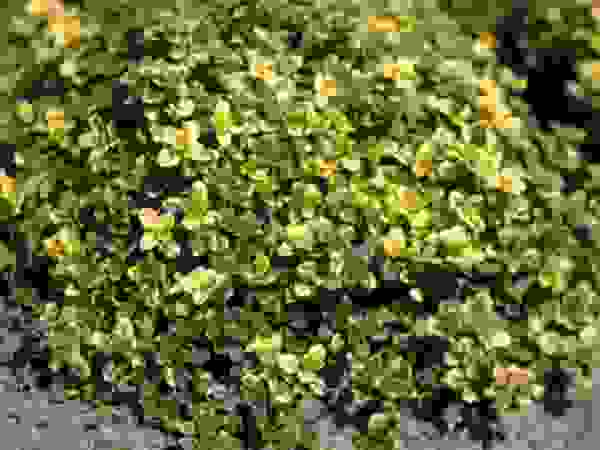
Citric
- Nectar... This variety allows you to grow a creeping plant, which flaunts pink flowers. The height of the bush reaches 25 cm. It has large and spicy foliage. How the planting and care of the Creeping Thuja takes place, you can find out by watching the video from the article.

Nectar
- Rainbow... The semi-shrub can grow up to 20 cm. It has fragrant leaves, which contain many vitamins and minerals. It will also be interesting to know what types of creeping juniper exist.

Rainbow
- Creeping... This is a perennial crop, the height of which reaches 15 cm. It has creeping stems of a cylindrical shape, and the shoots are hairy in the lower part and protruding. The leaves are petiolate and lanceolate. Their length reaches 1 cm. Flowers can be pink-lilac in color.

Creeping
What seeds look like
If you are buying thyme seeds, then you need to know what they look like. In fact, they are very small, dark in color and oblong in shape.
How and when to plant
Thyme propagation can occur in several ways. Each of them should be used in one way or another.
Seedless way
The seeds can be sent directly to the open field. Do it in the spring. It is not necessary to sow them very deeply. Planting depth is no more than 0.5-0.7 cm. Top with peat or sand. Then stretch the polyethylene, and when the first shoots are formed, it can be removed.
If you have chosen upright varieties, then place them on a plot according to the scheme 40-60 cm between rows and 10-20 cm between crops in a row. Thyme grows rather slowly at first.And as soon as the first leaves are formed, then thinning must be performed. You don't have to do this if the thyme is grown in a solid carpet.
The soil must be loosened and ensured that a crust does not form. You can get high germination if you plant before winter. In areas with a harsh climate, spud and cover adult crops with spruce branches. To prevent the culture from freezing in winter, it is necessary to mulch the soil or grow thyme as an annual plant.
Seedling method
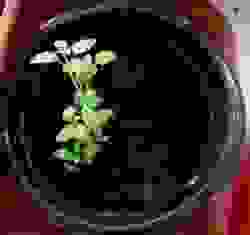
This method of growing thyme is considered the most reliable. The fact is that his seeds are tight-growing, and the sprouts appear small, so that in the open ground they can quickly die.
For growing seedlings, it is necessary to use containers with a depth of 8-10 cm. Fill the bottom with drainage material, the thickness of which is 2-3 cm. This is extremely necessary, since the plant requires a good outflow of water. To do this, you can use gravel, crushed stone or expanded clay.
On top, you can lay a layer of substrate, tamp it a little and water thoroughly with a spray bottle. Lay the planting material on the ground. It will also be interesting to know what Verbena seedlings look like.
At the same time, make sure that an area of 2x2 cm is allocated for one plant. You need to plant seedlings in the ground in 2-2.5 months. To do this, you need to choose a cloudy day, preferably after rain.
How to care
Thyme is easy to care for. Loosening of the soil remains very important for him. This will prevent stagnation of water in the roots and the formation of a crust on the surface of the earth. You also need to weed the bed to prevent weeds from forming. To make work easier, you can cover the area with compost.
You may also be interested in learning about how the planting takes place and how the care of the Iberis flower is organized.
Also, care will definitely include pruning. It should be done in early spring or when flowering ends. Shoots should be cut by 2/3. Such measures for thyme are extremely necessary, as this will allow you to get more compact and dense bushes.
The video shows how to care for a plant:
Watering
Thyme belongs to drought-resistant plants. Drought acts better on it than waterlogging. So it is worth watering the crop only when it is really needed. As soon as flowering has begun and young shoots have grown, then watering should be increased. But if the summer is moderately rainy, then irrigation of thyme may not be performed at all. But what kind of hoses for drip irrigation are, and how you can choose them, is detailed in this article.
Top dressing
As a rule, thyme does not need feeding, especially if the soil has been fertilized before planting. And if the soil is scarce, then you can add rotted compost to it in the form of mulch, or use horny flour for these purposes.
Pest and disease control
Thyme is quite resistant to diseases and pests. This is achieved due to the fact that it contains essential oil. But if agrotechnical measures are violated, then the plant can suffer from aphids, sandy sludge and other pests and diseases.
The meadow moth affects the underside of the leaves, forming a cobweb there. They can also feed on shoots and flowers. To prevent this, it is necessary to remove weeds in a timely manner, and dig up the soil in the fall. To destroy the pest, it is necessary to treat the thyme with Decis.
On the video - plant pest control:
Sandy sludge inflicts defeat on the terrestrial parts of the culture. To combat this pest, it is necessary to use baits poisoned with pesticides. Aphids injure the leaves and young shoots of the plant, as they feed on their sap. Means such as Antitlin and Biotlin can cope with it. Another pest is the weevil. It damages the flowers of thyme, as it lays the larvae in the buds.To combat the pest, it is worth treating the bush with Fitoverm.
If you take care of the thyme incorrectly, water it excessively, then it can get sick with fungal ailments. For treatment, it is worth using a solution of a fungicide - Ridomil, Fundazol, Topaz. High-quality prophylaxis will be a full care of the plant.
Thyme is a unique herb that today has several uses. It is used in medicine, cooking and gardening. Gardeners liked this culture because it is easy to care for it, but it is quite possible to decorate a flower bed in a beautiful and original way.


